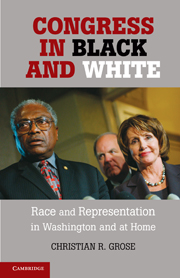Book contents
- Frontmatter
- Contents
- List of Figures and Tables
- Acknowledgments
- 1 African-American Legislators, African-American Districts, or Democrats?
- 2 A Unified Theory of African-American Representation in Congress
- 3 The “Hollow Hope” of Civil Rights Change in the U.S. House
- 4 Location, Location, Location
- 5 Constituency Service in the District
- 6 Bringing Home the Bacon
- 7 The Future of Racial Redistricting
- Appendix 1 Methods Used to Measure the Civil Rights Issue Space
- Appendix 2 Methods for Qualitative Research
- Appendix 3 Data, Methods, and Models for Project Allocations to African Americans
- References
- Index
3 - The “Hollow Hope” of Civil Rights Change in the U.S. House
Published online by Cambridge University Press: 03 May 2011
- Frontmatter
- Contents
- List of Figures and Tables
- Acknowledgments
- 1 African-American Legislators, African-American Districts, or Democrats?
- 2 A Unified Theory of African-American Representation in Congress
- 3 The “Hollow Hope” of Civil Rights Change in the U.S. House
- 4 Location, Location, Location
- 5 Constituency Service in the District
- 6 Bringing Home the Bacon
- 7 The Future of Racial Redistricting
- Appendix 1 Methods Used to Measure the Civil Rights Issue Space
- Appendix 2 Methods for Qualitative Research
- Appendix 3 Data, Methods, and Models for Project Allocations to African Americans
- References
- Index
Summary
“What really happened during the 1990s redistricting round[?] … [B]lack interests suffered as a result of this [racial redistricting maximization] …”
–David I. Lublin and D. Stephen Voss (2003)“If you go from a safe [black majority congressional] seat [to a black influence district], that is backsliding.”
–Justice John Paul Stevens, during questioning in Georgia v. Ashcroft, 2003 (from Cook 2003).“Racial redistricting results in the election of some liberal representatives, thereby shifting the House median to the left.”
–Kenneth W. Shotts (2003a, 226)“I don't want to … [increase my district's black population]. I believe it should be unconstitutional, if it's not, to stack black people in political ghettos.”
–Rep. Jim Clyburn, black Democrat from South Carolina's sixth district (from Associated Press 2001)Do majority-minority districting plans cause more liberal or more conservative civil rights policy outcomes in the aggregate U.S. House? Or is it possible that majority-minority districting plans have little to no impact on civil rights outcomes in the aggregate U.S. House? Whereas substantial debates have occurred over these questions in the fields of history, political science, law, and on the Supreme Court, there has always been an assumption that these districting plans have either benefited or harmed African Americans.
- Type
- Chapter
- Information
- Congress in Black and WhiteRace and Representation in Washington and at Home, pp. 54 - 86Publisher: Cambridge University PressPrint publication year: 2011



